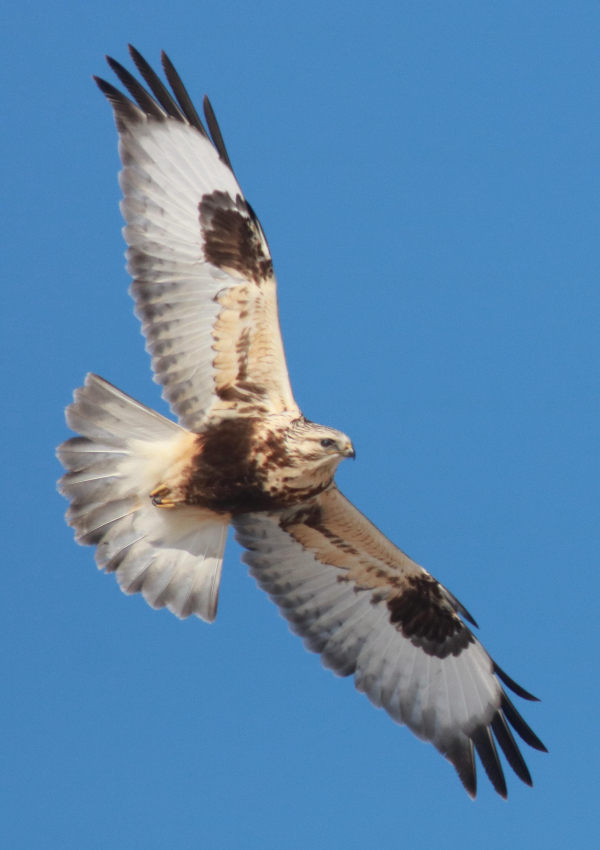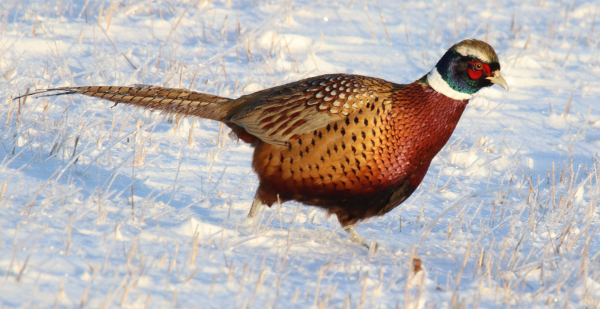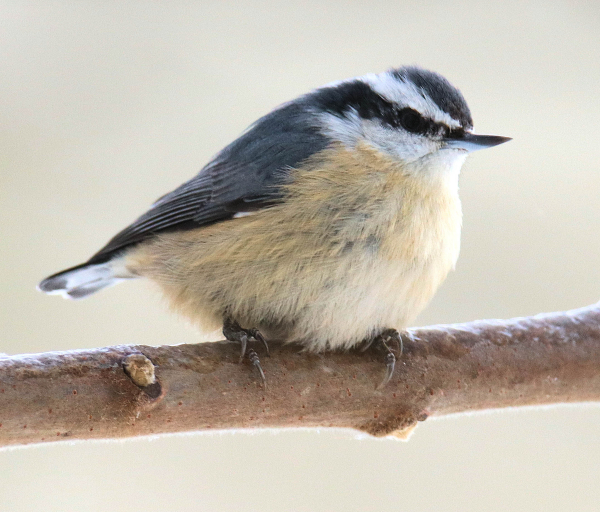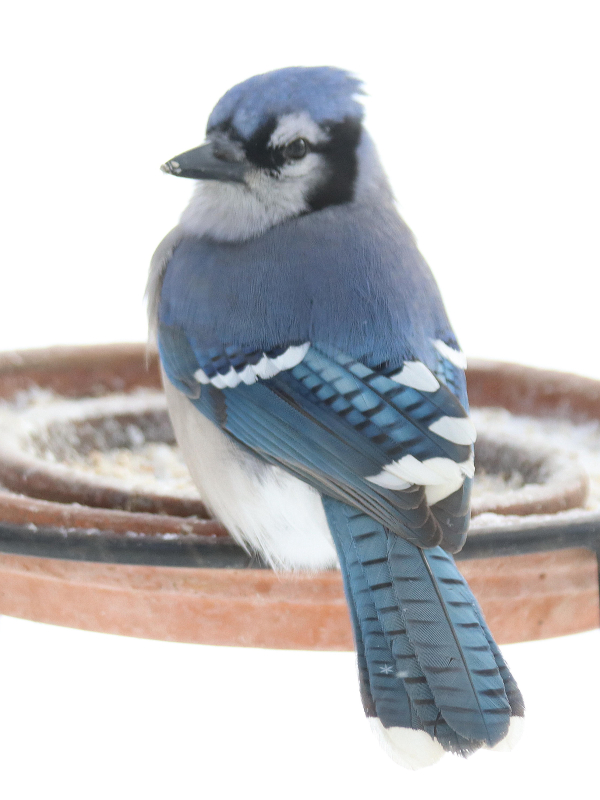 A Short-eared Owl on a hunting flight was the prize along an ice-covered landscape southeast of the refuge.  Three Rough-legged Hawks were among the most memorable birds encountered on the way to Sand Lake Refuge last Saturday.
 An obviously cold Ring-necked Pheasant was photographed as it ventured from snowy cover after the blizzard subsided.  Favorite feeding station visitors include Red-breasted Nuthatches and Blue Jays.  |
Rough-legged Hawks and a Short-eared Owl were indicators of the big change, along with the exit of geese – all 5 species of geese, plus all ducks and swans. It began overnight Wednesday, a snow blizzard, preceded by freezing rain and followed by sub-freezing temperatures and more wind. Terribly icy roads kept me homebound too long, and although I did a couple local drives Thursday and Friday, Saturday I headed southeast to Sand Lake National Wildlife Refuge to see if a few degrees of latitude would make a difference in short-stopping some geese, raptors, and other birds along the James River Valley north of Aberdeen.
Actually, I divided my bird lists into the 50 miles north of the border and 50 miles south of the border between the Dakotas, each with an interesting species mix. With the slightest breeze the temperature ranged between 11 and 13 degrees from my office to the border. On the north side I found 2 flocks of Snow Geese numbering about 45 each, one of which had about 25 Canada and Cackling Geese with it, and there were 2 other flocks of about 55 and 20 Snows. These would prove to be the last geese of the year in my area of the Coteau. I also observed 2 Rough-legged Hawks, fresh from the Arctic, and what might be the latest Red-tailed Hawk in the region too. Quite unusual was a sighting of 7 male Ring-necked Pheasants perched high in a lone cottonwood tree, far higher than I’ve witnessed before – between 40 and 60 feet above the thick cover the birds likely inhabited.
After crossing the borderline on my way to Sand Lake Refuge, I only saw a Rough-legged Hawk and a feeding flock of about 25 pheasants before reaching the refuge. There, I began seeing raptors, most notably 8 Bald Eagles in groups of 1, 2, 2, 2, and 1. I also observed 2 Northern Harriers, a female doing some aerial magic intent on unseen prey, and distant male on a coursing hunt. A tan Merlin was definitely hunting too, flying just above ground level as it approached a flock of about a dozen Horned Larks that flushed before it. There were also flocks of 50 and 40 Canada Geese in tiny open areas in the ice with a few Mallards mixed among them; and I sighted a lone Snow Goose and a lone White-fronted Goose too. The refuge also yielded looks at 2 groups of pheasants, numbering 4 and 2.
As I drove south on the paved road along the west side of the refuge, then east of the tiny town of Columbia, the going was concerning due to a super-slippery layer of frozen rain on the pavement, which rarely permitted me to drive more than 25 miles per hour. While North Dakota was white with snow, South Dakota was covered with a thick layer of frozen rain. Just east of Columbia I found a new bird for the season, a Short-eared Owl hunting on buoyant long wings above a dry marsh and adjacent harvested fields. As I was about to move on, the owl landed on an ice-covered plant that permitted me to take my best photo of it. Farther down the road I found a deep gravel pit lake that had open water with about 70 Canada Geese, 30ish Cackling Geese, and about 35 Common Goldeneyes with an adjacent flock of 18 Mallards. I was glad to get into the field to witness the finality of fall migration for most birds in this region, but when I returned home it was 7 degrees! Winter is here.
Before, During, and After the Blizzard
In advance of my Saturday birding drive to the refuge, prior to the blizzard local geese numbered a couple thousand – mostly Snow Geese, but also Ross’s, White-fronts, Canadas, and Cacklers. But throughout the day and night Wednesday, flocks of geese were calling overhead as they winged south; most hidden above low white clouds. Freezing rain preceded the snowy blizzard, making my drive to assess area waterfowl Thursday a bit worrisome. Only hundreds of geese remained during the storm, along with a few Ring-necked Ducks and Mallards.
Friday’s drive was just as slippery, even at low speeds, and I found a feeding mixed flock of a few hundred geese 4 miles north, and a male Northern Harrier in hunting flight near them. Breaking sunlight encouraged me to drive farther north, where the snow-covered landscape made me go into Snowy Owl search mode – funny how that works. No Snowys materialized, but I did find an especially cold-looking flock of 6 Ring-necked Pheasants huddled along the edge of a snow-covered cattail edge. Upon my return, a male pheasant had ventured into the open with the sun illuminating its vibrant plumage, providing me with a photo op, as did some of the other pheasants as they walked gingerly across the icy snow to a feeding area. I decided to check to the south too, and was surprised to find a flock of about 80 Snow Geese feeding and resting in the snow in a harvested cornfield, close, just beyond the road ditch and less than a mile south of my office.
After Saturday’s expedition to Sand Lake, I ventured from home a bit Sunday afternoon, but birding was bleak, and although I drove a 10 mile route that took me 8 miles north and 2 miles south, I only found one bird – an American Crow winging south! Crows are actually a rare sighting in this area of the open plains, especially after all the other migrants have passed on. Considering all lakes and marshes have frozen surfaces, birding beyond my yard seems less and less promising. But the action outside my windows continues to be pretty interesting with the promise of new birds in response to the seasonal change and snow cover.
Windowbirds
The birds in my yard began with a note of excitement when I sighted a Fox Sparrow foraging in an area of dried flowering plants I left to attract just such a bird – and more of them hopefully. I hoped the big ground-oriented native sparrow might forage toward my feeding station eventually, but like the male Purple Finch that preceded it last week, it turned out to be a one-day wonder. In advance of Wednesday night’s blizzard, the trio of American Goldfinches vanished as did the last Harris’s Sparrow, headed for better weather conditions to the south no doubt.
I expected the lone Dark-eyed Junco to do the same, but instead the species at least quadrupled in number, and by Saturday some juncos were feeding directly from my platform feeder in addition to their usual ground-oriented searches. Sunday began with male and female Downy Woodpeckers arriving at my feeding station together, the male feeding on seeds and the female opting for suet. At least 2 Red-breasted Nuthatches continue to visit, along with White-breasted Nutters, and at least 4 Blue Jays that add action and color to the feeders and water basin outside my bay windows, along with some bright red House Finches. Monday brought 4 surprises in the form of American Goldfinches, along with a few more Dark-eyed Juncos; 7 were present at the same time.
So the big change came and went with freeze-up and everything covered snow white, including all the tree branches that have a layer of hoarfrost. But while some birds evacuated, I’m waiting for newcomers from the north – finches – Pine Siskins, Common Redpolls, more Purple Finches, and maybe some crossbills or grosbeaks? Hmm, winter crossbills and grosbeaks are quite a stretch for this area, but I was caught up in a daydream for a moment.
Even so, with an early winter at hand, I’m already beginning a plan to search out those wonderful winter grosbeaks of the Sax-Zim Bog in northern Minnesota, along with the winter owls the area attracts – especially Great Gray Owls and Northern Hawk Owls. Then too, having traveled to South Dakota last Saturday, my thoughts turned to planning an initial visit to my SoDak raptor hotspot centered at the capitol of Pierre.
I can’t lament the short Arctic goose season too long; it’s time to hit the road to search out other exciting birds – if the sun ever clears away the clouds – ha-ha. It’s almost Thanksgiving, have you seen any Wild Turkeys lately? That’s fodder for another field trip in the Missouri River bottoms south of the capitol of Bismarck. Gee, that’s a lot of capitols – but enjoy a capitol week as we appreciate the change of seasons that will advance soon to a window near you.
Article and photos by Paul Konrad
Share your bird sightings and photographs at editorstbw2@gmail.com
